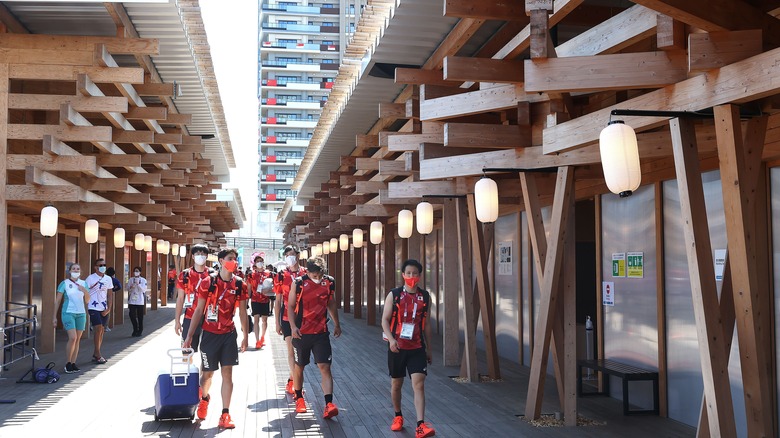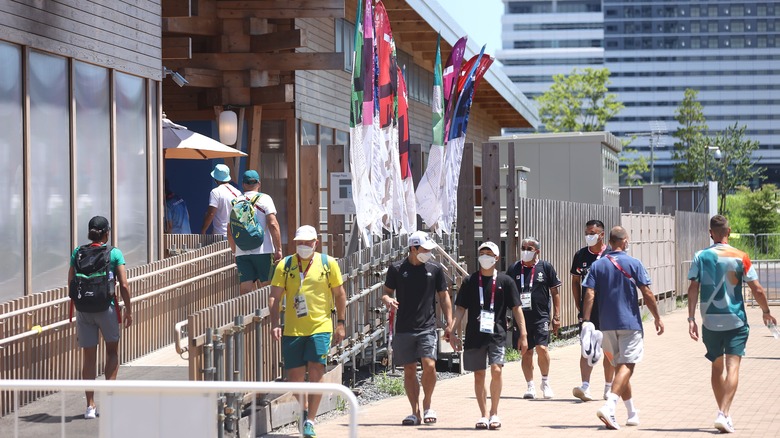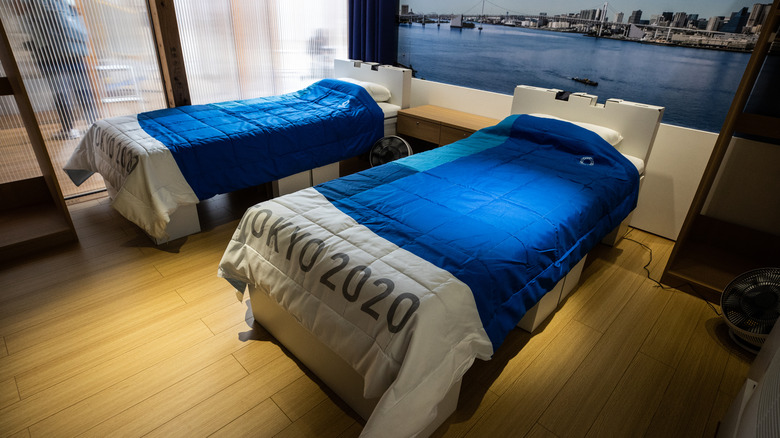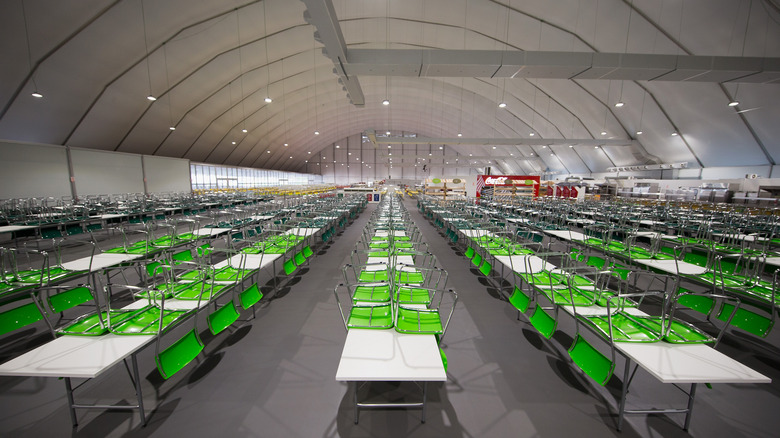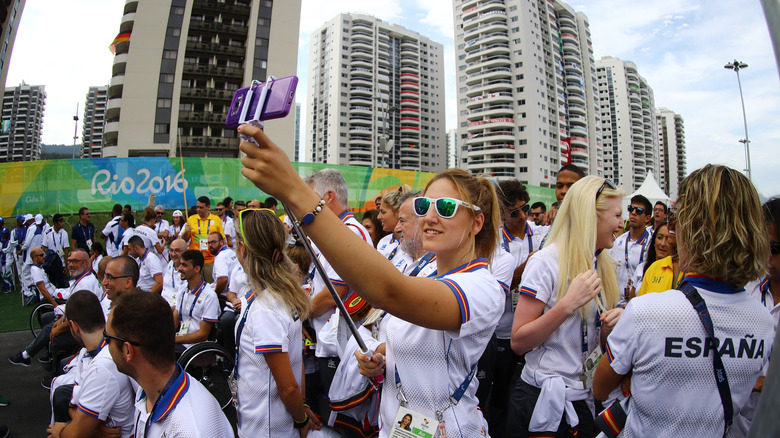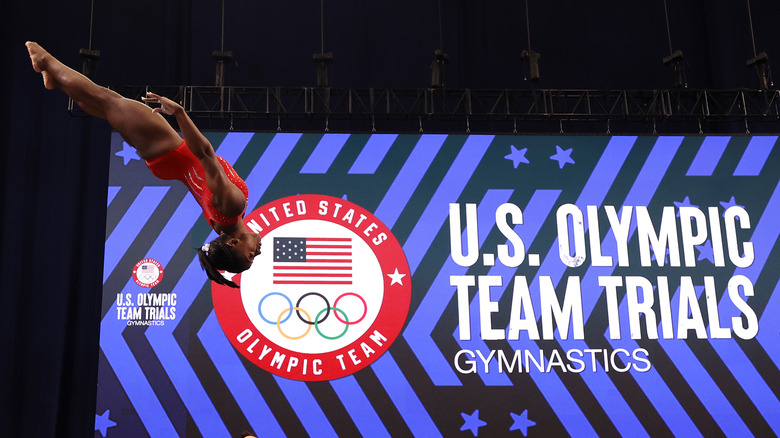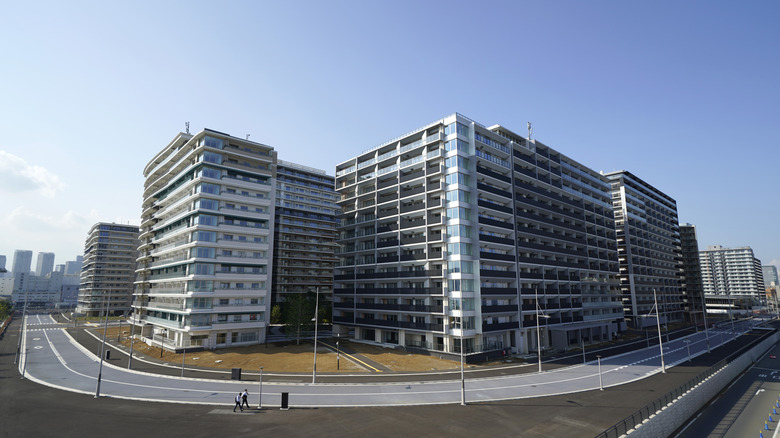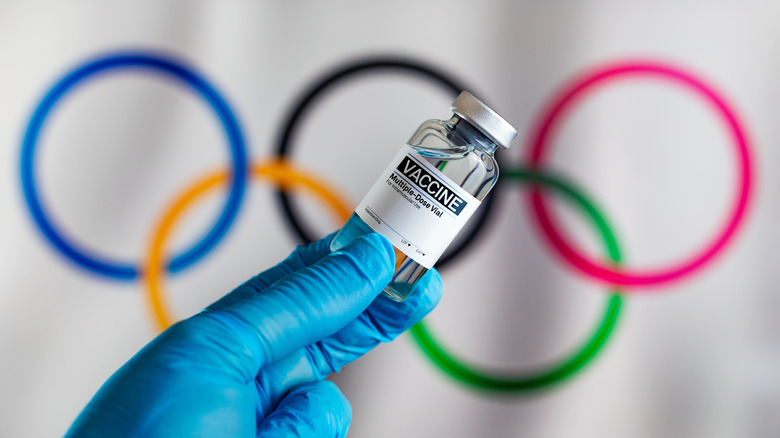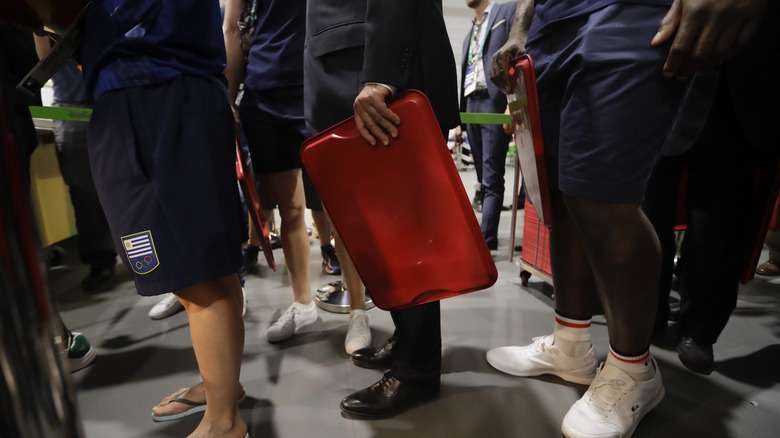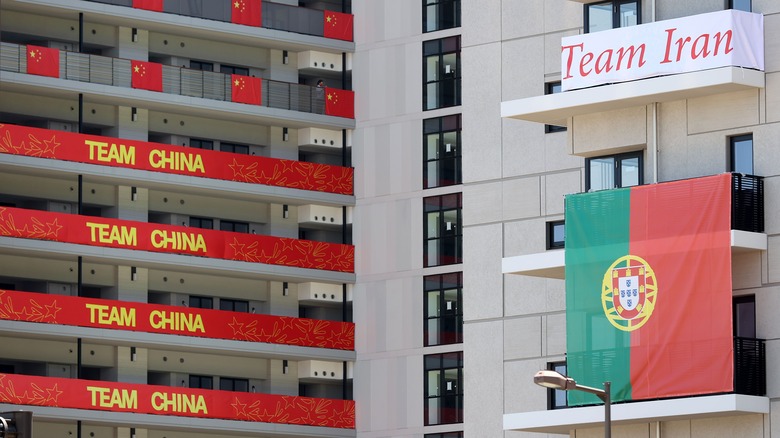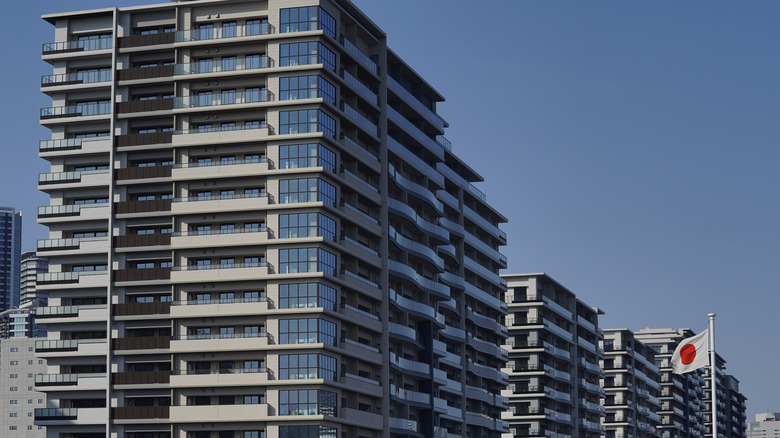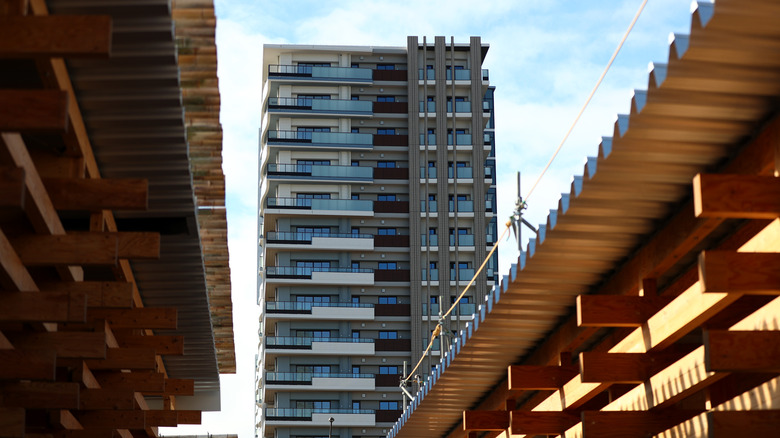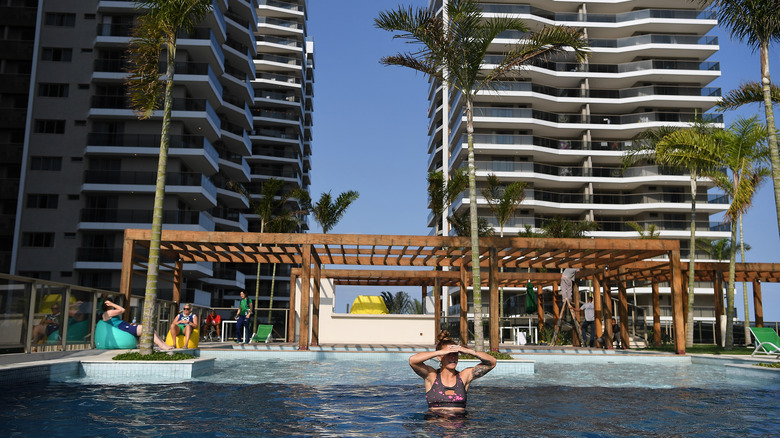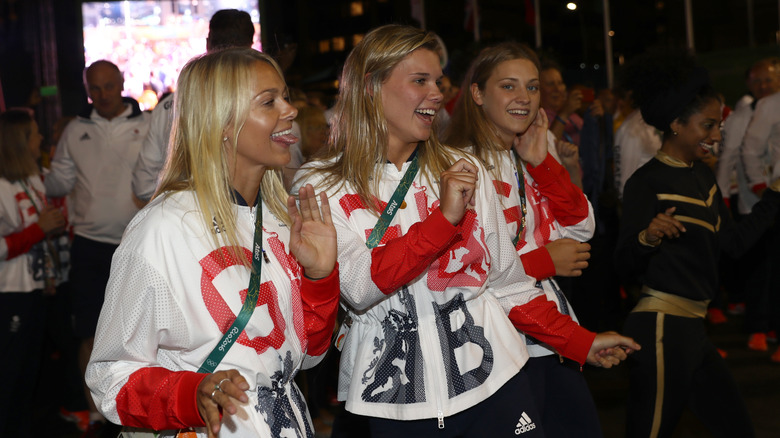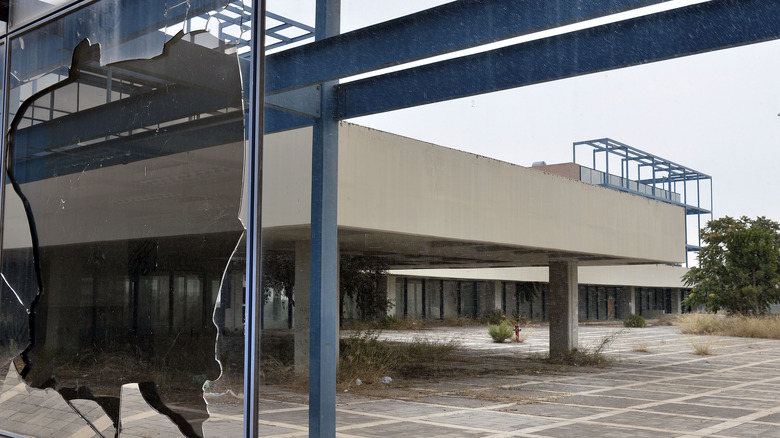Here's What Really Goes On At The Olympic Village
Picture it. You're back in middle school, your class is competing in the ultimate game of soccer, and you're determined to perform at the Olympic level. If you were lucky enough (and had good players on your team), you could come out of the game victorious, only to feel as though the podium was yours all along. Some athletes actually do make that dream a reality, and go on to represent their country at the Olympic Games. Of course, the Olympic Games are known for dazzling spectator experiences and insanely impressive athletic accomplishments, but it also just seems like a really good time.
Take the Rio Olympics in 2016. The entire event was colorful, sunny, and the Games gave off the impression that everyone was having a vacation as well as an amazing athletic experience. And even if you don't consider yourself to be a huge fan of the Olympics, you probably know that the athletes stay at the Olympic Village — a campus created specifically for the Games. But the Village is typically closed off to the public and press, and there's a lot of curiosity about it. So this is what really goes on at the Olympic Village — both during past Games and at the 2020 Tokyo Olympics.
COVID-19 has spread at the Olympic Village
It wouldn't be a 2021 event without COVID-19 (unfortunately), so let's start there. What happened at the Olympic Village in Tokyo — before the Games even started — is the spread of the coronavirus. As noted by Reuters, the "isolation bubble system" that organizers of the Games were counting on to protect the athletes staying at the Olympic Village has already been compromised — and with it has come a slew of concerns and worries over the athletes' safety. Given that it takes a negative COVID-19 test to even take part in the athlete's designated Olympic event, the spreading of the coronavirus is most definitely freaking out competitors who are already there.
Organizers announced that before the games began, dozens of cases of the coronavirus have been confirmed among those "accredited for the Games since July 1." Thomas Bach, the International Olympic Committee president, maintained that the testing and isolation measures in place created a "zero" risk environment for athletes staying at the Olympic Village, but clearly that is not the case. Who's to say exactly how things could play out in the Olympic Village in Tokyo, but it's not off to a great start.
The accommodations in Tokyo weren't as welcoming as some may have expected
We're not entirely sure what campuses of the past have looked like, but the term "Olympic Village" seems to scream a certain level of luxury, right? Well, the reality seems to be different. According to ESPN, the Olympic Village in Tokyo made quite the splash in the news because of the cardboard beds that were featured in the rooms. Yes, the bed frames were made of cardboard and no, we're not kidding. There were no comfy mattresses or nice wooden bed frames, but rather cardboard beds featuring polyethylene mattresses. What influenced such a decision? Sustainability. The Olympic committee committed to recycling the paper product-based beds after the Games conclude, which is definitely a great initiative, but an interesting choice for the housing of some of the world's greatest athletes.
However, the Olympic Villages of the past might not have been as fancy as we might have expected either. Olympian Natalie Coughlin told People that one of the "biggest misconception(s)" that audiences have is that the Olympic Village is luxurious. "I think they think it's a lot more glamorous than it is," she revealed. "It's really pretty boring."
This is the demand for food within the Olympic Village
Some athletes are known for their intense calorie intake, while others are known for adhering to strict diets. Either way, the food demand within the Olympic Village is wild. As reported by Japan Today, the Tokyo 2020 Olympic Village prepared to feed a lot of people — 18,000. Yes, you read that correctly, the Olympic Village in Tokyo can host around 18,000 people and as such, its dining halls have to be ready for the demand. About 48,000 meals were estimated to be served on a daily basis, and some dining options have to stay open at all hours of the day given the schedules of the athletes.
There are 700 menu options within the Olympic Village dining hall, 2,000 staff members, and 3,000 seats in the main cafeteria alone. The dining options at the Tokyo Games were categorized as Japanese, Western, and Asian, and will feature "plenty of local flavor." As for the senior director of the Games' food and beverages department, things got a bit overwhelming. "I feel it's a lot of responsibility for us," Tsutomu Yamane, the director in question, said. "We want them to enjoy Japanese food ... but it's major pressure."
The Olympic Village is typically the scene of post-win celebrations
The Olympic Games are full of exciting and emotional moments. From the amazing athletic performances to the opening and closing ceremonies, there's a lot to watch and celebrate. We feel like cracking open a bottle of champagne when the work week comes to an end, so we can't even imagine the level of excitement and celebration when a medal is snagged at the Olympic Games.
According to Olympians Mallory Weggemann and Alise Willoughby, who dished about the Games to Delish, the Olympic Village is where much of the Games' post-win celebrations happen, where the champagne is popped, and where athletes gather to toast their victory. While alcohol is not served at the Olympic Village dining hall (nor is it sold within Olympic Village at the Tokyo Games), athletes can still bring the bubbly with them (and we have a feeling they absolutely will). "There are usually plenty of options available for celebrations at the team houses that are definitely taken advantage of," Willoughby revealed. "When it's a time for a celebratory toast, you go with it! And in Rio, well ... One caipirinha, two caipirinha, three caipirinha, floor," she added while laughing. Sounds like a great time.
Some athletes abandon Olympic Village before the Games even started
There's something about the camaraderie within the Olympic Village that sounds like a fantastic, adult sleepover. Athletes are there with their friends, reunited with people they haven't seen in years, in an international country competing — all of it sounds really exciting. But the Tokyo Olympics in 2021 were certainly different due to COVID-19, and some athletes abandoned the Olympic Village before the Games even began.
As noted by the New York Post, members of the United States' women's gymnastics team decided to forego the Olympic Village altogether, and decided to stay in a local hotel instead. "It was also a decision that we all made together, we know it isn't ideal for the Olympic experience but nothing is ideal during a pandemic," Cecile Landi, who coaches Olympians Simone Biles and Jordan Chiles, posted on Twitter. "We feel like we can control the athletes and our safety better in a hotel setting."
Of course, the positive COVID-19 test of gymnastics alternative Kara Eaker certainly put things into perspective for the women's gymnastics team. Eaker, who received the COVID-19 vaccine, still caught the virus while at the Olympic training camp in Narita, Japan. So bye bye Olympic Village, hello hotel.
Here are the specs about the Tokyo Olympic Village
So we've gone over a bunch of other aspects that demystify the Olympic Village, but let's get into some stats. According to AP News, the Tokyo Olympic Village opened its doors to athletes on July 13, 2021, 10 days before the Olympics opened. The actual village itself was made up of 21 residential towers, each offering between 14 and 18 floors of accommodations. In total, there are 3,600 rooms within the Olympic Village, with a total of 18,000 beds throughout.
Now about the actual rooms themselves. AP News described them to be more like apartments, as they are about 1,200 square feet in size (for reference, the average size of a new apartment in the United States is about 941 square feet, according to RENTCafé). Each unit can sleep approximately eight athletes, with some rooms offering a little bit less space and as such, fewer beds. Approximately 11,000 athletes are expected to compete in the Olympic Games, so there should be room to spread competitors out so they're not all crammed in together. Due to COVID-19, athletes were asked to arrive as late as possible and leave as soon as they are able to.
The Tokyo Olympic Village initiated a 'fever clinic'
When we think of the Olympic Village, a lot of us probably envision relaxing pools, great hangout spots, an amazing dining hall, and maybe some game areas where the Olympic athletes can wind down after a long day of competition. And while some perks were promised at former Olympic Villages, Tokyo's version came with a much different vibe, and was equipped with none other than a "fever clinic." Yes, instead of sunshine and the excitement of competition, the Olympic Village was set up to handle disaster, and while the fever clinic is a much needed addition, it does sort of bring down the festivities of the Games quite significantly.
As reported by AP News, the clinic was setup as a "prefabricated complex of isolation rooms" located within the Olympic Village, on the shore of the Tokyo Bay. The clinic was designed to administer PCR (polymerase chain reaction) tests to athletes potentially exposed to COVID-19, and to address any spread of the virus accordingly. Run by Dr. Tetsuya Miyamoto, the senior director of the Medical Services Department for Olympic committee, the fever clinic is the last place that an Olympian wants to find themselves in.
Restrictions were put in place within the Olympic Village when it comes to this
The days of buffets seem to be completely gone due to COVID-19, as touching shared surfaces seems to be a thing of the past. As noted by AP News, the same restrictions made their way to the Olympic Village in Tokyo, and unlike Games of the past where food seemed to be a bit of a free-for-all, the Village in Tokyo was issued strict guidelines when it comes to preparing and serving food.
While we touched on just how much food is served during the Games, it should be noted that the meals at the Tokyo Games were instructed to be "handled only by cooks and servers." There will be no buffet-style options, plastic barriers will separate athletes while they dine, and even the soft serve soda handles will be covered in "anti-virus film" in order to curb the spread of COVID-19. All of this might sound like a bit much, but according to Our World in Data, only 23% of people in Japan are fully vaccinated against the novel coronavirus. When contextualized by the fact that only 13% of the world's total population had been inoculated by the start of the Games, the precautions make a ton of sense.
Athletes have displayed their country pride in this way at the Olympic Village
From Brazil to Australia to South Korea to New Zealand, countries from around the world travel to compete in the Olympics, and as such, athletes make themselves known throughout the Olympic Village. During the 2016 Olympic Games in Rio, the Olympic Village consisted of 31 high-rise apartment buildings — due to their location in the suburbs of Rio de Janeiro, the apartments were extremely visible. Athletes took to the outer surfaces of the buildings and planted their flags outside of their designated apartments. As more and more countries displayed their colors, the Olympic Village turned into a jigsaw of country pride.
As noted by The New York Times, it was up to Mario Cilenti, the director of the Rio Olympic Village, to place athletes and countries within the high-rise buildings. He did his best to situate countries with large delegations of athletes, and then worked in smaller countries throughout the remaining space. "It's a big jigsaw puzzle," Cilenti said of the task. "You start with the big pieces, and then you start filling in the smaller spaces." No matter what, spectators were left with an array of flags draping the Olympic Village, and Tokyo followed suit.
This specific kind of awareness is brought to the athletes who stay at the Olympic Village
From the amazing events to the wall-to-wall coverage, it really seems as though the Olympics shuts down the world for a couple weeks. But there are still aspects of the Games that viewers at home are not privy to, and one of those things has to do with, you guessed it, sex. Maybe the last topic on our minds when watching the Games, protecting athletes from STIs and unwanted pregnancies seems to be a priority when the Olympics comes around, and yes, we were a little stunned too.
According to AP News, 150,000 condoms were said to have been given out to athletes at the Tokyo Olympic Village for the 2020 Games, and we were just as shocked as you probably are now. However, Takashi Kitajima, the Olympic Village general manager, said that handing out protection was part of an awareness campaign regarding HIV and AIDS. "The purpose of distributing condoms is not [just] to use in the village, but to ask athletes to cooperate for the awareness of the issue by bringing the condoms back home to their countries," Kitajima explained.
The Olympic Village is basically just packed with super stressed out athletes
When we ask the question of what really goes on inside the Olympic Village — as it has been shrouded by curiosity — what we're really wondering is what athletes get up to when they're not competing. According to Olympian Natalie Coughlin, the Olympic Village is pretty much just full of stressed out athletes. So many of us see the Olympics as this bright, glittering event that marks every two years with immense talent, but inside the Olympic Village are thousands of competitors who are painstakingly prepping for what could be the most important performance of their lifetime.
"[The Olympic Village] is like a giant college campus — except that everyone is getting ready for the biggest event of their life so they're incredibly stressed," Coughlin told People. "They're really, really focused and so everyone is 100% on their best behavior up until the time that they're done competing." Coughlin even shared that once athletes have wrapped up all their competitions, they typically leave the Olympic Village "for the sake of the athletes who are still competing." After all, it's no fun watching the people around you party and celebrate when you still have more competition ahead.
Each Olympic Village varies in what it offers
One of the amazing aspects about the Olympic Games is that each year, a different country is chosen to host. Each Games looks a little different, and the same can be said for the Olympic Village. Athletes have dished about the difference between Villages, and all of the options sound just as exciting as each other, according to People. For instance, Alexi Pappas shared that during the Rio de Janeiro Games in 2016, there were "free condoms, Dance Dance Revolution and all the limited edition athlete-only golden Coca-Cola bottles you can get your hands on." Talk about a wild combination.
During the South Korea Games in 2018, the Olympic Village featured a number of McDonald's locations where athletes could purchase some of their favorite fast-food items. Olympic runner Allyson Felix told People that the common fast-food joint was "one of the most popular stops" at the Olympic Village, and the line was already incredibly long. "Sometimes when you're just across the world, you want something that you know exactly what it's going to taste like," she revealed.
The Olympic Village is one of the best places for athletes to socialize
The Olympic Village is one of the best places for athletes to socialize while competing at the Games. As Olympic swimmer Natalie Coughlin shared with People, of all the locations within the Village, the cafeteria is by far the best place to be. Of course, the dining tables are great for chatting with fellow competitors, but Coughlin shared that the dining hall also provides amazing people watching opportunities. It also provided her the chance to play one of her favorite pastimes: trying to guess what sport someone at the Village competes in just based on their appearance and body type (we can imagine that height is a significant factor, especially when guessing gymnasts or basketball players, the two ends of the height spectrum).
Comparing the dining hall to the size of a Costco, Coughlin said that the location within the Village is by far where the action is. Of course, it also gives athletes a chance to run into some of sporting's biggest stars. Coughlin recalled that while competing in the 2012 Games in London, the entire room broke into applause when Usain Bolt entered the Village — sounds like quite the time.
What happens to the Olympic Village once the Games are complete?
We've talked about just about everything that goes on in Olympic Villages. But what happens when the Games end? Well according to AP News, the apartment blocks built for the Tokyo Games will be sold to occupants once the Games are over. Hopefully that plan will come to fruition, but we'd be remiss not to mention the amount of Olympic Villages and Olympic arenas that have been abandoned after the Games come and go from a city.
As reported by ABC News, a slew of Olympic Villages have been left in various levels of decay for quite some time. For instance, the Olympic Village in Athens, Greece from the 2004 Games was used as a "worker housing project," but now most of the buildings are "abandoned or rarely used." The buildings used to house athletes during the 1936 Games in Berlin are completely decayed or deserted, and if you think that the 1930s was a long time ago and that decay is reasonable after all this time, we should note that the Olympic Village used in the 2006 Games in Turin is abandoned too. Fingers crossed the Olympic Village in Tokyo is put to good use.
